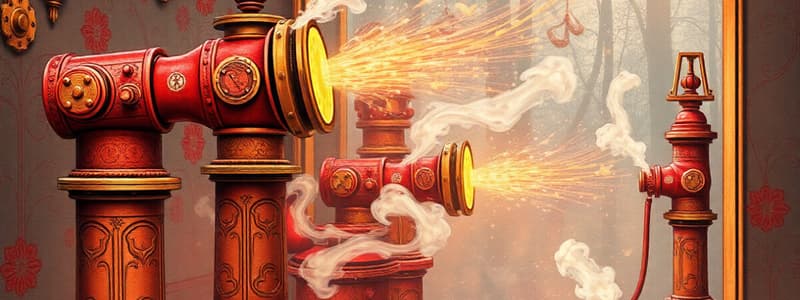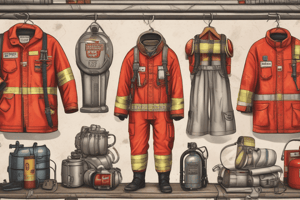Podcast
Questions and Answers
What is the lowest operating pressure that a solid tip nozzle can operate with?
What is the lowest operating pressure that a solid tip nozzle can operate with?
- 40 PSI (correct)
- 50 PSI
- 60 PSI
- 30 PSI
Why is a solid-tip nozzle often preferred for standpipe use?
Why is a solid-tip nozzle often preferred for standpipe use?
- It operates at a higher pressure.
- It readily passes through rust and scale. (correct)
- It has a more complex design.
- It can produce a high fog stream.
What size nozzle is mandated for the first line operated from a standpipe in the FDNY?
What size nozzle is mandated for the first line operated from a standpipe in the FDNY?
- 1 3/4-inch with a solid tip
- 1 1/2-inch with a fog tip
- 2 1/2-inch with a solid tip (correct)
- 3-inch with a dual-pressure tip
What is the primary advantage of using a fog tip in standpipe operations?
What is the primary advantage of using a fog tip in standpipe operations?
What design feature is required for all nozzles used in standpipe operations?
What design feature is required for all nozzles used in standpipe operations?
What is the required outlet valve pressure for four lengths of 2 1/2-inch hose flowing 250 gpm?
What is the required outlet valve pressure for four lengths of 2 1/2-inch hose flowing 250 gpm?
What was the historical maximum pressure at the top-floor outlet for fire department equipment?
What was the historical maximum pressure at the top-floor outlet for fire department equipment?
Which hose sizes are recommended if a department requires a higher water volume?
Which hose sizes are recommended if a department requires a higher water volume?
What was the minimum pressure at 2 1/2-inch outlets after the 2013 edition of NFPA 14 was published?
What was the minimum pressure at 2 1/2-inch outlets after the 2013 edition of NFPA 14 was published?
What flow rate can a 1 1/8-inch solid-tip nozzle produce at 65 psi through 100 feet of 2 1/2-inch hose?
What flow rate can a 1 1/8-inch solid-tip nozzle produce at 65 psi through 100 feet of 2 1/2-inch hose?
What is not listed as a tool to carry in a standpipe kit?
What is not listed as a tool to carry in a standpipe kit?
Why might adaptors be necessary in the kit?
Why might adaptors be necessary in the kit?
Which tool is explicitly mentioned as necessary alongside the spanner wrench?
Which tool is explicitly mentioned as necessary alongside the spanner wrench?
What might happen to the operating wheel of the outlet valve?
What might happen to the operating wheel of the outlet valve?
What size of pipe wrench is mentioned as a requirement?
What size of pipe wrench is mentioned as a requirement?
What is the primary function of wooden door chocks during fire safety operations?
What is the primary function of wooden door chocks during fire safety operations?
Why are door-latch search markers important in search operations?
Why are door-latch search markers important in search operations?
Which piece of equipment is NOT listed as necessary on the fire floor?
Which piece of equipment is NOT listed as necessary on the fire floor?
What is the primary reason for using portable radios during fire operations?
What is the primary reason for using portable radios during fire operations?
What is an appropriate procedure if the fire is above the seventh floor?
What is an appropriate procedure if the fire is above the seventh floor?
What does OSHA state as the minimum number of FFs allowed?
What does OSHA state as the minimum number of FFs allowed?
What is a consequence of using two 2 1/2-in. lines instead of a single 5-in. line when supplying water to a firefighting system?
What is a consequence of using two 2 1/2-in. lines instead of a single 5-in. line when supplying water to a firefighting system?
What might necessitate bypassing the siamese connection during firefighting operations?
What might necessitate bypassing the siamese connection during firefighting operations?
What is a key consideration when assessing the effectiveness of the siamese supply line?
What is a key consideration when assessing the effectiveness of the siamese supply line?
Once enough personnel are available to ensure the rapid advance of the first line, what should additional personnel be committed to?
Once enough personnel are available to ensure the rapid advance of the first line, what should additional personnel be committed to?
What simplifies the connection to the first or second floor outlets?
What simplifies the connection to the first or second floor outlets?
What indicates that a pump is churning water with little or no flow?
What indicates that a pump is churning water with little or no flow?
What is the recommended starting discharge pressure for standpipe systems on the fifth floor?
What is the recommended starting discharge pressure for standpipe systems on the fifth floor?
Why might smaller diameter hoses require a higher starting pressure than a 2 1/2-inch line?
Why might smaller diameter hoses require a higher starting pressure than a 2 1/2-inch line?
What is the discharge pressure required for a fog nozzle on the eighth floor?
What is the discharge pressure required for a fog nozzle on the eighth floor?
What additional pressure is needed when using a fog nozzle compared to a solid-tip nozzle for the same floor level?
What additional pressure is needed when using a fog nozzle compared to a solid-tip nozzle for the same floor level?
Flashcards
NFPA 14 Standard
NFPA 14 Standard
A standard that sets guidelines for fire department hose and nozzle pressures.
2 1/2-inch hose maximum pressure (pre-1993)
2 1/2-inch hose maximum pressure (pre-1993)
65 psi at the top-floor outlet.
NFPA 14 1993 pressure change
NFPA 14 1993 pressure change
Increased maximum allowable pressure at 2 1/2-inch outlets to 175 psi.
2013 NFPA 14 minimum pressure
2013 NFPA 14 minimum pressure
Signup and view all the flashcards
Hose pressure sufficiency
Hose pressure sufficiency
Signup and view all the flashcards
Hose length increase
Hose length increase
Signup and view all the flashcards
Hose size for residential buildings
Hose size for residential buildings
Signup and view all the flashcards
Nozzle pressure limitation
Nozzle pressure limitation
Signup and view all the flashcards
Standpipe nozzle preference
Standpipe nozzle preference
Signup and view all the flashcards
Low-pressure nozzle importance
Low-pressure nozzle importance
Signup and view all the flashcards
Standpipe Nozzle Pressure
Standpipe Nozzle Pressure
Signup and view all the flashcards
Solid Tip Nozzle Advantage
Solid Tip Nozzle Advantage
Signup and view all the flashcards
FDNY Standpipe Line Requirement
FDNY Standpipe Line Requirement
Signup and view all the flashcards
Fog Nozzle for Ventilation
Fog Nozzle for Ventilation
Signup and view all the flashcards
Standpipe Nozzle Design
Standpipe Nozzle Design
Signup and view all the flashcards
Pipe Wrench Necessity
Pipe Wrench Necessity
Signup and view all the flashcards
Spanner Wrench Purpose
Spanner Wrench Purpose
Signup and view all the flashcards
Hose Thread Adaptor Use
Hose Thread Adaptor Use
Signup and view all the flashcards
Why Are Adapters Necessary
Why Are Adapters Necessary
Signup and view all the flashcards
Standpipe Outlet Valve Problem
Standpipe Outlet Valve Problem
Signup and view all the flashcards
Standpipe Wrench
Standpipe Wrench
Signup and view all the flashcards
Wooden Door Chocks
Wooden Door Chocks
Signup and view all the flashcards
Door-Latch Search Markers
Door-Latch Search Markers
Signup and view all the flashcards
Search Policy
Search Policy
Signup and view all the flashcards
Standpipe Operation
Standpipe Operation
Signup and view all the flashcards
Forcible Entry Tools
Forcible Entry Tools
Signup and view all the flashcards
Initial Fire Floor Equipment
Initial Fire Floor Equipment
Signup and view all the flashcards
Venting for Early Fires
Venting for Early Fires
Signup and view all the flashcards
Multi-Floor Advance Strategy
Multi-Floor Advance Strategy
Signup and view all the flashcards
Elevator Use in Fires
Elevator Use in Fires
Signup and view all the flashcards
Siamese Connection
Siamese Connection
Signup and view all the flashcards
Standpipe Inlet
Standpipe Inlet
Signup and view all the flashcards
Double Female Connection
Double Female Connection
Signup and view all the flashcards
Pressure-Regulating Valves
Pressure-Regulating Valves
Signup and view all the flashcards
Inadequate Siamese Supply
Inadequate Siamese Supply
Signup and view all the flashcards
Low Flow Detection
Low Flow Detection
Signup and view all the flashcards
Starting Discharge Pressure
Starting Discharge Pressure
Signup and view all the flashcards
Friction Loss
Friction Loss
Signup and view all the flashcards
Fog Nozzle Pressure
Fog Nozzle Pressure
Signup and view all the flashcards
High-Rise Pump Pressures
High-Rise Pump Pressures
Signup and view all the flashcards


